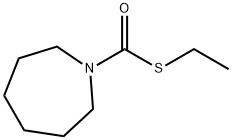Uses
Selective herbicide used to control the germination of annual grasses and broadleaved
weeds in rice crops.
Definition
ChEBI: Molinate is a member of the class of azepanes that is azepane in which the nitrogen is substituted by an (ethylsulfanyl)carbonyl group, -C(=O)SEt. A thiocarbamate herbicide not approved for use in the U.S. or European Union, it is used control grass weeds in rice paddies. It has a role as an antispermatogenic agent, a herbicide and an agrochemical. It is a member of azepanes and a monothiocarbamic ester.
General Description
Clear liquid with aromatic odor. Non corrosive. Used as an herbicide.
Air & Water Reactions
Water soluble. Thio and dithiocarbamates slowly decompose in aqueous solution to form carbon disulfide and methylamine or other amines. Such decompositions are accelerated by acids.
Reactivity Profile
Molinate is a thiocarbamate. Flammable gases are generated by the combination of thiocarbamates and dithiocarbamates with aldehydes, nitrides, and hydrides. Thiocarbamates and dithiocarbamates are incompatible with acids, peroxides, and acid halides.
Agricultural Uses
Herbicide: Molinate is a selective herbicide used on rice for the
control of water grass and other weeds.
Trade name
ARROSOLO®; FELAN®; HIGALNATE®;
HYDRAM®; JALAN®; MALERBANE-GIAVONI-L®;ORDAM®; ORDRAM®; R-4572®; RICECO;
SAKKIMOL®; STAUFFER R 4,572®; YALAN®; YULAN®
Environmental Fate
Soil. Hydrolyzes in soil forming ethyl mercaptan, carbon dioxide and dialkylamine
(half-life approximately 2–5 weeks) (Hartley and Kidd, 1987). At recommended rates of
application, the half-life of molinate in moist loam soils at 21–27°C is approximately 3
weeks (Humburg et al., 1989). Rajagopal et al. (1989) reported that under flooded conditions,
molinate was hydroxylated at the 3- and 4-position with subsequent oxidation
forming many compounds including molinate sulfoxide, carboxymethyl molinate, hexahydroazepine-
1-carbothioate, 4-hydroxymolinate, 4-hydroxymolinate sulfoxide, hexahydroazepine,
S-methyl hexahydroazepine-1-carbothioate, 4-ketomolinate, 4-hydroxyhexahydroazepine,
4-hydroxy-N-acetyl-hexahydroazepine, carbon dioxide and bound
residues.
Plant. Molinate is rapidly metabolized by plants releasing carbon dioxide and naturally
occurring plant constituents (Humburg et al., 1989).
Photolytic. Molinate in a hydrogen peroxide solution (120 mM) was irradiated by UV
light (l = 290 nm) at 23°C. The major photooxidation products were the two isomers of
2-oxomolinate (20% yield) and s-molinate oxide (5% yield) (Draper and Crosby, 1984).
Half-lives of 180 and 120 hours were observed using one and two equivalents of hydrogen
peroxide, respectively (Draper and Crosby, 1984). Molinate has a UV absorption maximum
at 225 nm and no absorption at wavelengths >290 nm. Therefore, molinate is not expected
to undergo aqueous photolysis under natural sunlight (l = 290 nm). In the presence of
tryptophan, a naturally occurring photosensitizer, molinate in aqueous solution photodegraded
to form 1-((ethylsulfinyl)carbonyl)hexahydro-1H-azepine, S-ethyl hexahydro-2-
oxo-1H-azepine-1-carbothioate and hexamethyleneimine (Soderquist et al., 1977).
Chemical/Physical. Metabolites identified in tap water were molinate sulfoxide, 3- and
4-hydroxymolinate, ketohexamethyleneimine and 4-ketomolinate (Verschueren, 1983).
Metabolic pathway
Juvenile white sturgeon and common carp are
exposed to 14C-molinate in a flow-through metabolism
system and oxidize molinate to form several products
and hydrolyze or conjugate with glutathione (GSH),
the sulfoxide, or sulfone. Both fish form a D-glucuronic
acid conjugate. The higher toxicity of molinate in
common carp may be due to greater bioconcentration,
slower depuration, and less efficient metabolic
deactivation. In the blood of common carp, molinate is
oxidized by erythrocytes to the sulfoxide and possibly
the sulfone, then conjugated with GSH or cysteine and
cleaved to form mercapturic acid in both erythrocytes
and plasma. Conjugation and possible hemoglobin
carbamylation occur only after sulfoxidation of
molinate. Molinate is distributed uniformly throughout
the soil layers, and its degradation products are identified as 2-oxomolinate, 4-oxomolinate, molinate
acid, and hexamethyleneimine. In rice plants,
4-hydroxymolinate, 2-oxomolinate, 4-oxomolinate,
S-ethyl-N-carboxymethylthiocarbamate, molinate acid,
and molinate alcohol are detected. By the soil
microorganisms, oxidation of the S-ethyl moiety is
considered to be the main pathway, and hydroxy and
oxoderivatives on the azepine ring are identified.




